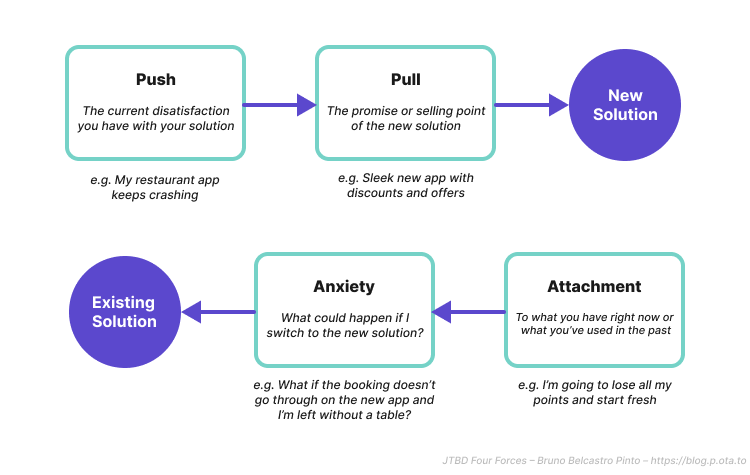JTBD Four Forces – The reasons behind hiring and firing
In my latest post, I discussed how to build products people love using Jobs-to-be-Done, a theory that provides a framework to help uncover your customers’ needs.
The Jobs-to-be-done theory focuses on understanding why customers use products or services to change a particular life situation, and it’s a very useful framework when doing discovery in the product development process.
Building up on the basics about JTBD and how job stories work, there’s an additional concept introduced by Clayton Christensen that’s helpful to understand the process customers go through when switching to a new digital solution: the four forces.
The four forces

The four forces concept was introduced to the Jobs-to-be-Done framework to illustrate the dynamics involved behind the “hire and fire” actions that customers go through when evaluating their choice of a product or service.
Crafting and understanding the JTBD Forces behind a switch is a helpful exercise when developing the product’s value proposition, as it helps prioritise features that will make adoption of our product easier for customers.
The four forces are Push, Pull, Attachment, and Anxiety. Let’s dig a little bit deeper into what these all mean:
Push (or Pain)
Push, or pain, is the struggle or problem ‘pushing’ your customer to look for a new product or service, moving away from the product or service they use or have used in the past. (e.g. My restaurant app keeps crashing)
Pull (or Promise)
Pull, or promise, is what attracts the customer to your product, rather than staying with the existing solution or using a different one. (e.g. A sleek new app with discounts and special offers)
Attachment
Attachment compiles the reasons why they would prefer -or need- to stick with the current solution. It can also refer to why it’s harder for the customer to switch to a different solution because they are being locked somehow. (e.g. I’m going to lose all my points if I start fresh)
Anxiety
Anxiety refers to any concerns or worries the customer has about your product. (e.g. What if the booking doesn’t go through on the new app and I’m left without a table?)
Help customers make the switch
The JTBD four forces can help your product development team design, build and market products in a way that’s coherent with the different steps customers are going through when deciding what to hire as a solution.
Understanding the four forces behind a product switch can help you align your acquisition strategy with your value proposition, as there’s a connection between pains and gains.
It can also ensure your solution has enough pull and push to leverage your product against the attachment to your competitor’s solution and ease any potential anxiety your customers face when making the switch